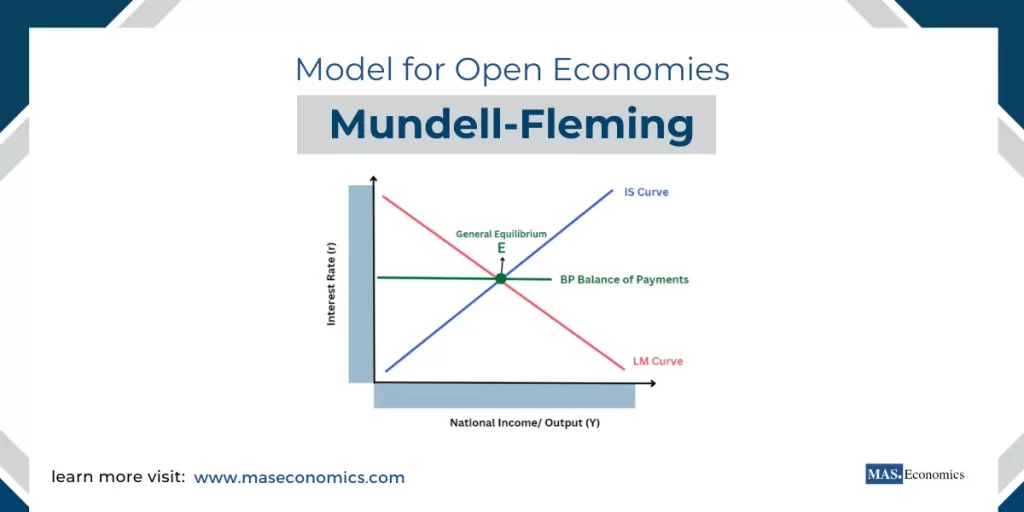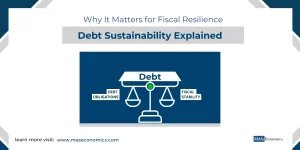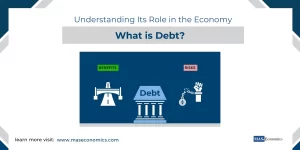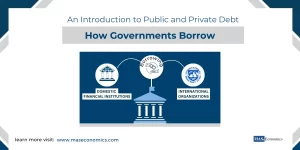The Mundell-Fleming model extends the IS-LM framework to analyze open economies, taking into account international capital flows and exchange rate mechanisms. Developed by Robert Mundell and Marcus Fleming, the model helps us understand the trade-offs policymakers face when managing exchange rates, capital mobility, and domestic economic objectives. It is particularly useful for analyzing the effectiveness of monetary and fiscal policies in an open economy setting, under different exchange rate regimes.
In this article, we will delve into the Mundell-Fleming model, exploring how different policy tools work under varying levels of capital mobility and how exchange rate mechanisms influence outcomes.
The IS-LM-BP Framework
The Mundell-Fleming model incorporates an additional curve into the IS-LM framework called the Balance of Payments (BP) curve. This curve represents the balance between inflows and outflows of foreign capital and trade balances. By combining the IS curve (Investment-Saving), the LM curve (Liquidity Preference-Money Supply), and the BP curve (Balance of Payments), the Mundell-Fleming model provides a comprehensive view of macroeconomic equilibrium in an open economy.
To visualize this concept better, consider the diagram below that illustrates the General Equilibrium in the Mundell-Fleming Model. This diagram will help you understand the complex interactions between the goods market, the money market, and international capital flows.
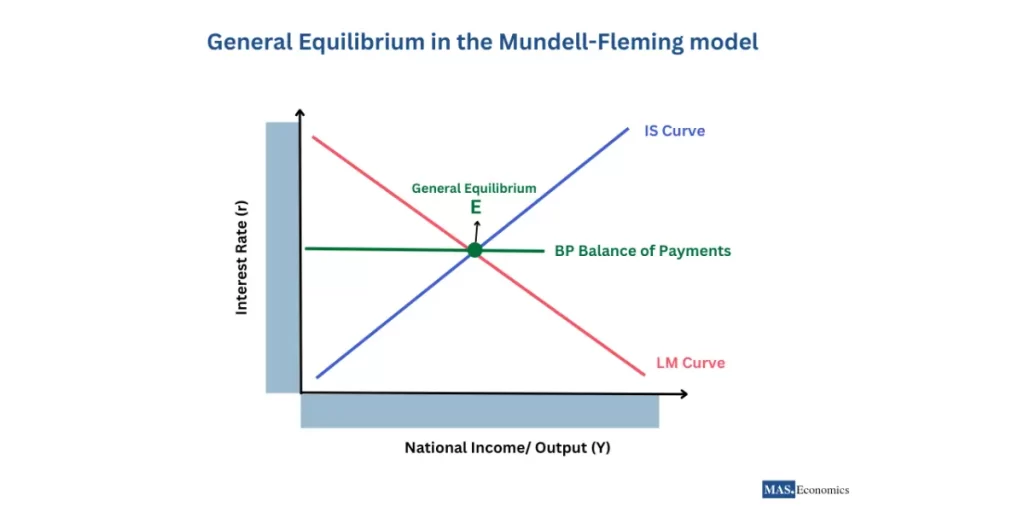
In the diagram above, the IS curve (in blue), the LM curve (in red), and the BP curve (in green) intersect at point E, which represents the general equilibrium of an open economy. This equilibrium determines the combination of interest rate (r) and national income (Y) at which the goods market, the money market, and the balance of payments are simultaneously in equilibrium.
The BP curve is positively sloped, meaning that as the income level (Y) increases, there must be a corresponding increase in the interest rate (r) to attract sufficient capital inflows to maintain the balance of payments equilibrium. The balance of payments incorporates both current account transactions (trade of goods and services) and capital account transactions (flows of capital, such as investments). By incorporating the BP curve, the Mundell-Fleming model illustrates how international factors influence domestic macroeconomic outcomes.
Policy Analysis under Different Exchange Rate Regimes
The Mundell-Fleming model provides insights into how fiscal and monetary policies work under different exchange rate regimes—fixed exchange rate and floating exchange rate. The model also highlights the constraints faced by governments in managing policy in a globalized environment.
Fixed Exchange Rate Regime
Under a fixed exchange rate regime, the central bank intervenes in the foreign exchange market to maintain a specific exchange rate. In this scenario, fiscal policy becomes highly effective. For instance, an increase in government spending shifts the IS curve to the right, raising both income and interest rates. However, to maintain the fixed exchange rate, the central bank must intervene by increasing the money supply, shifting the LM curve to the right, and preventing the interest rate from rising. This results in a significant increase in income with no change in the interest rate.
Conversely, monetary policy is largely ineffective under a fixed exchange rate because any attempt by the central bank to change the money supply would be offset by foreign exchange interventions. For example, if the central bank tries to increase the money supply to lower interest rates, capital outflows would create downward pressure on the currency. To stabilize the exchange rate, the central bank would need to sell foreign reserves, effectively neutralizing the impact of monetary expansion.
Flexible Exchange Rate Regime
In a flexible exchange rate regime, the exchange rate is determined by market forces, and the central bank does not intervene to stabilize it. In this case, monetary policy becomes highly effective, while fiscal policy is somewhat constrained.
An expansionary monetary policy, such as an increase in the money supply, shifts the LM curve to the right, lowering the interest rate. A lower interest rate causes capital outflows, leading to a depreciation of the currency. The depreciation makes exports cheaper and imports more expensive, which boosts net exports (NX) and further increases national income. Therefore, under a flexible exchange rate, monetary policy has a dual effect: lower interest rates stimulate domestic investment, while currency depreciation boosts net exports.
On the other hand, fiscal policy is less effective under a flexible exchange rate. An increase in government spending shifts the IS curve to the right, increasing income and interest rates. Higher interest rates attract foreign capital, leading to an appreciation of the domestic currency. Currency appreciation reduces net exports, partially offsetting the initial increase in income caused by higher government spending.
The Policy Trilemma (Impossible Trinity)
One of the key insights of the Mundell-Fleming model is the concept of the policy trilemma or the impossible trinity. According to this concept, a country can achieve only two of the following three objectives simultaneously:
- Exchange Rate Stability – Maintaining a fixed exchange rate.
- Monetary Policy Autonomy – The ability to set domestic interest rates.
- Free Capital Mobility – Allowing unrestricted flows of capital in and out of the country.
For instance, a country with a fixed exchange rate and free capital mobility cannot have an independent monetary policy. This is because any change in domestic interest rates would lead to capital flows that destabilize the exchange rate, requiring intervention by the central bank to maintain stability. On the other hand, a country with a flexible exchange rate can enjoy monetary policy autonomy even with free capital mobility, as the exchange rate adjusts to offset capital flows.
Practical Case Studies
To understand the policy trilemma better, let’s consider some real-world examples.
China has often chosen exchange rate stability and monetary policy autonomy while limiting capital mobility. By tightly controlling capital flows, China has been able to maintain a fixed exchange rate (or a managed float) while pursuing independent monetary policy to support domestic economic growth.
India, on the other hand, has adopted a flexible exchange rate regime with relatively free capital mobility. This allows the Reserve Bank of India (RBI) to use monetary policy to target inflation and growth. However, this comes at the cost of exchange rate volatility, which can make international trade and investment more uncertain.
Shocks and Dynamic Adjustments in the Mundell-Fleming Model
The Mundell-Fleming model also provides a framework for understanding how economies adjust to shocks under different exchange rate regimes. Consider a demand shock, such as a sudden increase in foreign demand for a country’s exports. Under a fixed exchange rate, the central bank would need to intervene to prevent currency appreciation by increasing the money supply, which shifts the LM curve to the right and supports higher income.
Under a flexible exchange rate, the same demand shock would lead to an appreciation of the domestic currency, which could dampen the initial boost in exports. Policymakers would need to balance the benefits of increased income against the potential loss of competitiveness due to currency appreciation.
Conclusion
The Mundell-Fleming model is a vital extension of the IS-LM framework that helps us understand how macroeconomic policies function in an open economy setting. By incorporating the effects of exchange rate regimes and capital mobility, the model provides valuable insights into the effectiveness of fiscal and monetary policies under different conditions.
The concept of the policy trilemma underscores the inherent trade-offs that countries face in pursuing their economic objectives. Whether dealing with the challenges of fixed exchange rates, the advantages of flexible exchange rates, or the complexities of managing capital flows, the Mundell-Fleming model remains a crucial tool for policymakers aiming to navigate the global economic landscape.
FAQs:
What is the Mundell-Fleming model?
The Mundell-Fleming model is an extension of the IS-LM framework, designed to analyze open economies. It explains how monetary and fiscal policies interact with exchange rates and capital flows under different exchange rate regimes. The model adds the Balance of Payments (BP) curve to the IS-LM framework, accounting for trade balances and capital mobility.
What is the Policy Trilemma (Impossible Trinity)?
The policy trilemma states that a country cannot simultaneously achieve exchange rate stability, monetary policy autonomy, and free capital mobility. A country must choose two of the three:
- Fixed exchange rate and free capital mobility: Requires giving up independent monetary policy.
- Monetary autonomy and free capital mobility: Requires flexible exchange rates.
- Fixed exchange rate and monetary policy autonomy: Requires restricting capital mobility.
How do fiscal and monetary policies function under a fixed exchange rate regime?
Fiscal policy becomes highly effective. When government spending increases, the IS curve shifts right, raising income. The central bank intervenes to maintain the exchange rate, increasing the money supply, which supports fiscal expansion. However, monetary policy is ineffective. Attempts to lower interest rates lead to capital outflows, forcing the central bank to sell reserves, neutralizing the money supply increase.
How do policies work under a flexible exchange rate regime?
Monetary policy is very effective. Increasing the money supply shifts the LM curve right, lowering interest rates and causing currency depreciation, which boosts net exports and income. Fiscal policy becomes less effective. Increased government spending shifts the IS curve right, raising income and interest rates. This attracts capital inflows, leading to currency appreciation, which reduces net exports and offsets some of the fiscal stimulus.
What role does capital mobility play in the Mundell-Fleming model?
The effectiveness of monetary and fiscal policies depends on the degree of capital mobility. With perfect capital mobility, even small interest rate changes trigger large capital flows. Fiscal policy becomes more powerful under fixed exchange rates, while monetary policy is more effective under flexible exchange rates. Under imperfect capital mobility, the BP curve slopes upward. Both monetary and fiscal policies retain some effectiveness, but with more complex dynamics since capital flows respond gradually to interest rate differences.
How does the Mundell-Fleming model apply to emerging economies?
Emerging economies face challenges such as capital flight and currency volatility. To manage these risks, some countries use managed exchange rates and capital controls, maintaining partial autonomy over monetary policy while controlling exchange rate fluctuations. For example, India uses a managed float exchange rate system with selective capital controls to balance domestic economic stability and international trade participation.
Can the Mundell-Fleming model explain policy challenges in the Eurozone?
Yes, the Eurozone illustrates the policy trilemma. Member countries gave up monetary policy autonomy by adopting the Euro and maintaining exchange rate stability. However, without individual control over monetary policy, countries face challenges in responding to economic crises, as they cannot devalue their currency or adjust interest rates independently.
How do exchange rates impact policy effectiveness?
Currency depreciation under flexible exchange rates boosts net exports by making domestic goods cheaper abroad, amplifying the effects of monetary expansion. Currency appreciation due to capital inflows makes exports more expensive, reducing net exports and offsetting fiscal stimulus under a flexible exchange rate regime.
What are real-world examples of the Mundell-Fleming model in action?
The Bretton Woods system exemplified the trilemma. Countries pursued exchange rate stability and capital mobility but had to give up monetary policy autonomy. The system eventually collapsed due to difficulties maintaining fixed exchange rates. China maintained a fixed exchange rate with strict capital controls to retain control over domestic monetary policy. During the post-2008 financial crisis, the U.S. used expansionary fiscal and monetary policies, while a flexible exchange rate allowed the dollar to adjust freely, aiding economic recovery.
Why is the Mundell-Fleming model important for policymakers?
The Mundell-Fleming model helps policymakers understand the trade-offs between different policy goals in an open economy. It provides a framework for balancing fiscal and monetary policies with exchange rate and capital flow management, helping countries navigate global economic challenges effectively.
Thanks for reading! Share this with friends and spread the knowledge if you found it helpful.
Happy learning with MASEconomics

